Cannon-ball tree
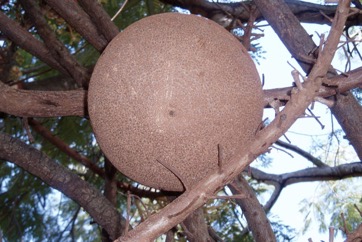
It is native to tropical America. A tropical plant. It is very sensitive to frost. Plants need lots of water and humidity. It grows on flood plains. In the Cairns Botanical Gardens. It suits plant hardiness zones 11-12.
Also known as:
Amyauk-san-bin, Bala de canon, Buah kanon, Coco de mono, Dau lau, Kailaspati, Pohon peluru meriam, Pohon sala, Sa-lah, Sala-lan-kaa
Synonyms
- Couroupita antilliana Miers
- Couroupita saintcroixiana R. Kunth
- Couroupita surinamensis Mart. ex Berg
- and others
Edible Portion
- Fruit
Where does Cannon-ball tree grow?
Found in: Amazon, Asia, Australia, Brazil, Central America, Costa Rica, Cuba, Dominican Republic, East Africa, Guiana, Guianas, Guyana, Haiti, Hawaii, Honduras, India, Indochina, Indonesia, Laos, Mozambique, Myanmar, North America, Pacific, Pakistan, Panama, Peru, SE Asia, Singapore, South America, Sri Lanka, Suriname, Thailand, United States, Venezuela, Vietnam, West Indies
Notes: There are 3-4 Couroupita species.
Growing Cannon-ball tree
Cultivation: Plants are grown from seed. The fruit are cracked open and the seeds removed, washed and dried in the sun. Germination is slow. Fresh seed should be planted. They germinate in 8-15 days and can be transplanted in 5-7 months.
Edible Uses: The pulp is eaten and made into a beveridge.
Production: Plants grow quickly. They can be 2.5 m tall in 2 years. The fruit ripen in 8 months.
Nutrition Info
per 100g edible portion| Edible Part | Energy (kcal) | Protein (g) | Iron (mg) | Vitamin A (ug) | Vitamin c (mg) | Zinc (mg) | % Water |
|---|---|---|---|---|---|---|---|
| - | - | - | - | - | - |
Cannon-ball tree Photos

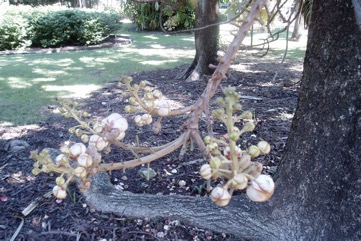
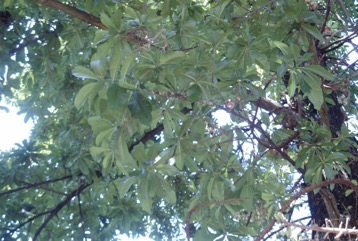
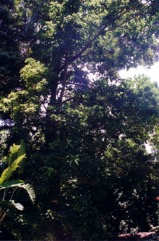
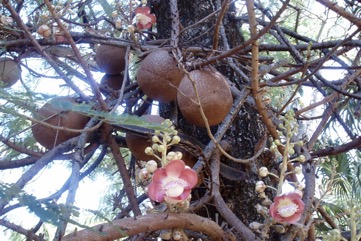
References
Ambasta, S.P. (Ed.), 2000, The Useful Plants of India. CSIR India. p 144
Andrade, E. H. A. et al, 1999, Seed Composition of Amazonian Lecythidaceae Species: Part 3 in the Series ‘‘Studies of Edible Amazonian Plants’’. Journal of Food Composition and Analysis 12:37-51
Barwick, M., 2004, Tropical and Subtropical Trees. A Worldwide Encyclopedic Guide. Thames and Hudson p 134
Beasley, J., 2011, Plants of Tropical North Queensland - the compact guide. Footloose publications. p 184
Bodkin, F., 1991, Encyclopedia Botanica. Cornstalk publishing, p 293
Bole, P.V., & Yaghani, Y., 1985, Field Guide to the Common Trees of India. OUP p 23
Condit, R., et al, 2011, Trees of Panama and Costa Rica. Princeton Field Guides. p 260
Cundall, P., (ed.), 2004, Gardening Australia: flora: the gardener's bible. ABC Books. p 429
Engel, D.H., & Phummai, S., 2000, A Field Guide to Tropical Plants of Asia. Timber Press. p 38, 99
Etherington, K., & Imwold, D., (Eds), 2001, Botanica's Trees & Shrubs. The illustrated A-Z of over 8500 trees and shrubs. Random House, Australia. p 238
Hedrick, U.P., 1919, (Ed.), Sturtevant's edible plants of the world. p 223
Heywood, V.H., Brummitt, R.K., Culham, A., and Seberg, O. 2007, Flowering Plant Families of the World. Royal Botanical Gardens, Kew. p 184
Hist. pl. Guiane 2:708, t. 282. 1775
Llamas, K.A., 2003, Tropical Flowering Plants. Timber Press. p 244
Martin, F. W., et al, 1987, Perennial Edible Fruits of the Tropics. USDA Handbook 642 p 97 (Also as Couroupita surinamensis)
McMakin, P.D., 2000, Flowering Plants of Thailand. A Field Guide. White Lotus. p 18
Morley, B. & Everard, B., 1970, Wild Flowers of the World. Ebury press. Plate 179
Perry, F., and Hay, R., 1982, Guide to Tropical and Subtropical Plants. Sun Books p 24
Schuler, S., (Ed.), 1977, Simon & Schuster's Guide to Trees. Simon & Schuster. No. 97
Smith, N., et al, 2007, Amazon River Fruits. Flavors for Conservation. Missouri Botanical Gardens Press. p 136
Staples, G.W. and Herbst, D.R., 2005, A tropical Garden Flora. Bishop Museum Press, Honolulu, Hawaii. p 369
Sukarya, D. G., (Ed.) 2013, 3,500 Plant Species of the Botanic Gardens of Indonesia. LIPI p 212
Swaminathan, M.S., and Kochnar, S.L., 2007, An Atlas of Major Flowering Trees in India. Macmillan. p 162
Young, J., (Ed.), 2001, Botanica's Pocket Trees and Shrubs. Random House. p 289
Zuchowski W., 2007, Tropical Plants of Costa Rica. A Zona Tropical Publication, Comstock Publishing. p 275